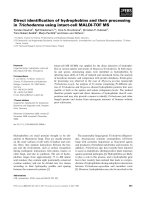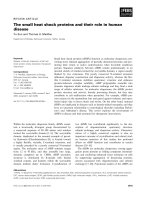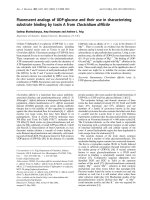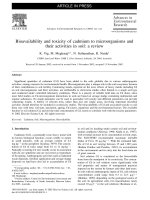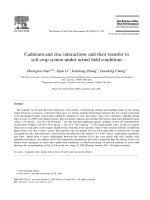PROBIOTICS AND THEIR USE IN
Bạn đang xem bản rút gọn của tài liệu. Xem và tải ngay bản đầy đủ của tài liệu tại đây (1.5 MB, 49 trang )
PROBIOTICS AND THEIR USE IN
AQUACULTURE
April 2006
10th Aquaculture Insurance and
Risk Management Conference
Presented by:
William P. Long
Chief Executive Officer
Epicore BioNetworks Inc.
BASIC AQUACULTURE
MARKET NEEDS
To survive and make money
To overcome problems of:
Pond crashes
Farm abandonment
Low survival
Poor quality animals
Low weights
Poor feed conversion ratio (FCR)
It’s not a hobby; it’s a business!
MURPHY’S LAW
Whatever can go wrong, will go wrong!
Mismanagement
Weak PL, bad feed, inadequate oxygen, poor
harvest procedures
Natural events
Weather, predators
Disease
Theft
Crop market prices
THE SCIENCE OF SURVIVAL
Through microbiological science
aquaculturists can fight Murphy's Law
Probiotics are a natural, environmentally
friendly application of microbiology
TRADITIONAL DISEASE CONTROL
UNDER FIRE
Many
older antibiotics proven unsafe
so are banned from all uses
Shrimp with antibiotic residues
cannot be sold in many major
markets
State of art antibiotics should be
reserved for humans
ROLE OF ENVIRONMENTAL
MICROBIOLOGY IN AQUACULTURE
Pollution control
Bioremediation of wastes
Cleaner water & pond bottoms
Disease resistance imparted by creating a
lower stress growing environment
Probiotic action
Directly protects animals from disease
Pathogenic Vibrio parahemolyticus, Vibrio harveyi
bacteria, Aeromonas
Indirectly protects from some viral diseases
POLLUTION CONTROL
Waste is major problem in aquaculture pond and
hatchery waters
Affects animal health and vigor
Lowers harvest yield value
Forces frequent water exchange
A biosecurity risk
Bacteria are nature’s chosen waste degraders
End result of microbial action is biomass - a soil
amendment
Harnessing the power of
nature’s microbial
workforce
BIOREMEDIATION MODE OF ACTION
Aquaculture wastes are organic in nature
Microorganisms “eat” organic wastes
Bacteria + N + C + P + O2 = More Bacteria + H2O + CO2
Microorganisms digest pollutants
Ammonia: very toxic to crustaceans and fish
Nitrite: very toxic to crustaceans and fish
And is food for disease causing Vibrio
Nitrate: too much causes algae crashes
Pond bottom waste: release nutrients in older
ponds to promote natural algae bloom without
added fertilizer
WHAT IS A PROBIOTIC
A
live microbial supplement that
benefits the host animal
– From the Greek “probios”:
Pro = “for”
Opposite
Bios = “life”
of antibiotic
– A microbial killer or suppressant
PROBIOTIC MODES OF ACTION
Competitive exclusion
Out-competes pathogenic bacteria for nutrients
Displaces pathogens from gut wall sites
Produces acids in gut to inhibit pathogenic
bacteria
Bacteriocin (antimicrobial) excretion
Repels or kills pathogenic bacteria
Stimulates immune response
Aids digestion
Produces enzymes to help digest & absorb feed
Reduces toxic amines
PROBIOTIC BENEFITS vs.
ANTIBIOTICS
Probiotic use eliminates need for antibiotics
Probiotics create no illegal residue
Bacteria cannot develop resistance to
probiotics but can to antibiotics
Antibiotics lead to slow growth rate of larvae
Probiotics boost immune system of shrimp
Probiotics also digest pollutants
Probiotics promote high survival so are costefficient to use
Cheaper to use probiotics than antibiotics
PROBIOTICS AND VIRUSES
Anecdotal evidence that probiotics
mitigate pathogenicity of WSSV virus
– Pond in Vietnam saved by double does of
probiotic after WSSV outbreak
– Pond in Mexico with same experience after
PCR testing and mortality confirmed WSSV
presence
Some researchers believe probiotics
stimulate shrimp immune response
Some researchers believe that probiotics
mitigate WSSV by controlling secondary
pathogens
PROBIOTIC COMPOSITION
Single strain of live microorganism
Usually bacterial or yeast
e.g. Lactobacillus acidophilus, Saccharomyces
cerevisae, Vibrio alginolyticus
Lactic bacteria typical of human probiotics
Microbial ecosystems
Mixtures of specially selected, live but dormant
microorganisms
Synergistic mixtures
High strength for economy of use
Usually are dry powders
Excellent shelf life if kept dry
WHY MICROBIAL ECOSYSTEMS?
Teams work better than individuals
– Ecosystems work better than single strains
What makes a good ecosystem?
– Enough “players” on the “team”
High cell count (cfu = colony forming units)
– Enough of the right types of “players”
More than one type (i.e. strain)
Too many strains is bad (poor QC, low individual
count)
– High quality “players” of each type
Best strain for each intended purpose (e.g. enzyme
production or specific waste digestion)
Safe microorganisms
TYPICAL AQUACULTURE PROBIOTIC
Selected live microorganisms like:
Bacillus spp., Lactobacillus spp., Yeast
Soil-based, non-toxic, not genetically modified
Not close relative of pathogens
Minimum strength = 2E+09 CFU/gm
i.e. 2,000,000,000 colony forming units per gram
Fortified with a broad spectrum of free
enzymes to start waste digestion
Contains proprietary growth stimulants
Free of pathogens and toxins
Biodegradable carrier
TYPICAL PROBIOTIC
PRODUCT
PROBIOTIC SUCCESS FACTORS
Existence of water quality or disease problem
Use proper dosage & treatment frequency
Follow literature or ask local distributor
Time to work
Bacteria, unlike chemicals, take time to work
For curative application allow 24-48 hours
Organic matter present
Add biological growth media to new or lined ponds
Proprietary media or home-made (e.g. sucrose-based)
Salinity
Good probiotics are tolerant but best in salinity <40 ppt
Pond pH – tolerant but best at 6-10
Temperature: Slower at low temperatures
AMMONIA DIGESTION
Ammonia (TAN) Concentration Over Time at Various Dose Rates of EPICIN
EPICIN
(mg/l)
4.0
0
error bars represent +/- sd
TAN (mg/l)
3.0
10
2.0
50
1.0
0.0
0
1
2
3
4
5
Time (Days)
• Probiotics take time to work
• Ammonia digestion is dose sensitive
SALINITY TOLERANCE
4
TAN (ppm)
3.5
3
2.5
48
37
24
12
0
2
1.5
1
0.5
0
0
1
2
Time (days)
3
ORGANIC CARBON IMPORTANCE
4
TAN (mg/l)
3.5
3
2.5
2
1.5
1
0.5
0
0
22
43
64
86
Total Organic Carbon (mg/l)
Works best with organic carbon present
PROBIOTIC HYDRATION
Best to hydrate (or “wake up”) dormant
bacteria
Success factors
Water quality: use clean or disinfected pond
water
Neutralize disinfectants before adding PROBIOTICS
Aeration: use air stone or stir frequently
Time: follow literature for hydration time
Growth media
Specially designed media offers control and
optimum growth
Pond-side grow-up lowers treatment costs
PROBIOTIC CELL GROWTH
Cell Count (billion cfu/ml)
HYDRATION IN POND WATER
600
500
400
300
200
100
0
0
2
4
6
8
10
12
Grow-up time (hours)
Growth reverses unless special growth media is used
PROBIOTIC GROW-UP WITH MEDIA
In FRESH and SEA WATER
4.0E+08
3.5E+08
cfu/ml
3.0E+08
2.5E+08
Fresh Water
Sea Water
2.0E+08
1.5E+08
1.0E+08
5.0E+07
0.0E+00
0.0 hrs
4.0 hrs
8.0 hrs
Slightly more growth in fresh water;
BGM media allows more growth
PROBIOTICS BENEFIT
THROUGHOUT THE LIFECYCLE
In
maturation
– To produce the eggs
In
hatcheries
– To produce the juveniles
In
grow-out
– To produce the adults
PROBIOTICS IN
GROW-OUT PONDS



